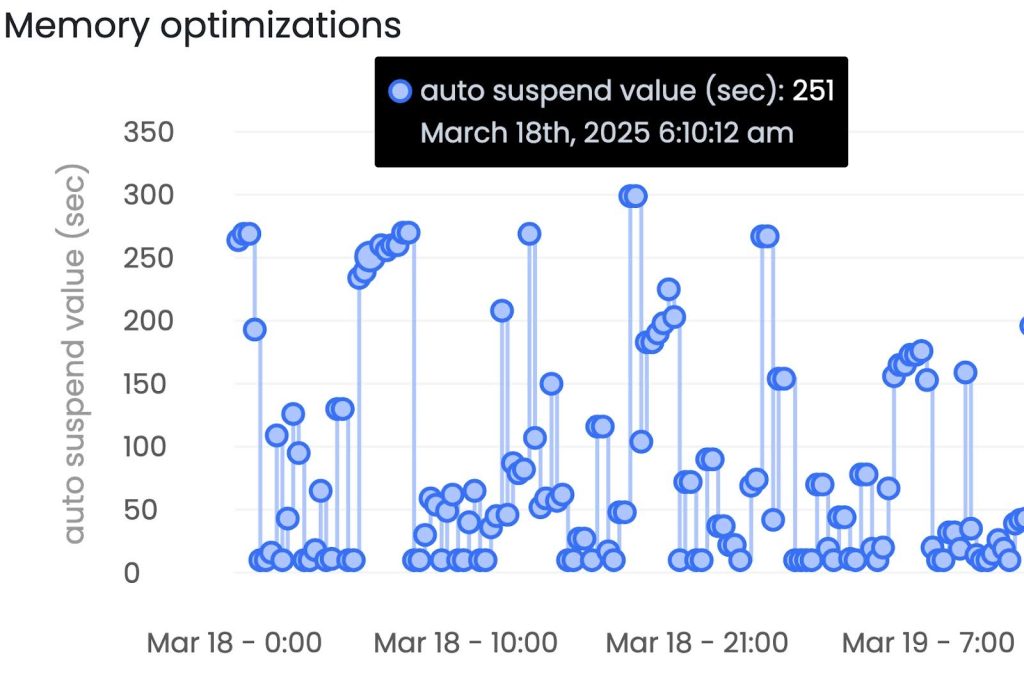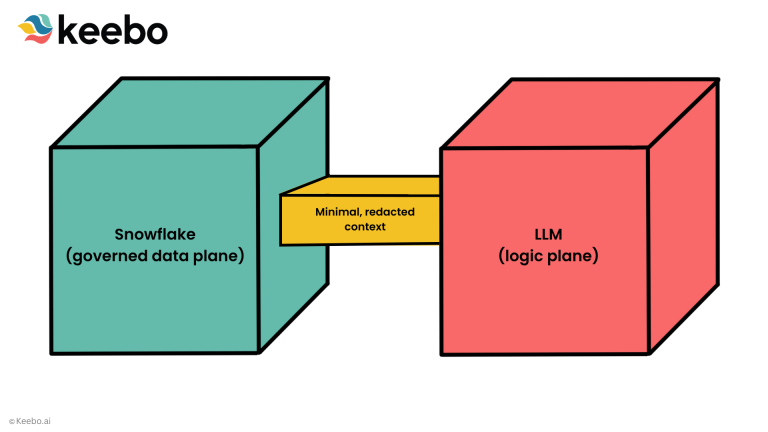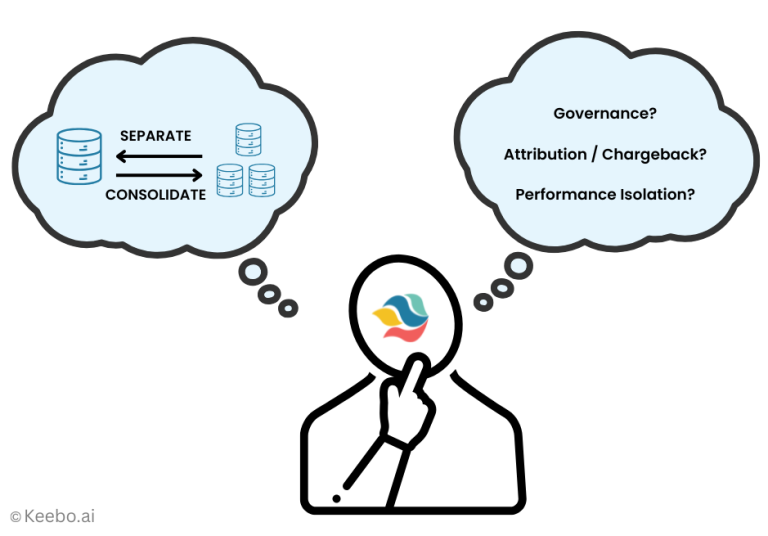How Your “Experts” Have Been Misleading You About Snowflake Auto Suspend Settings
Reducing excessively large Auto Suspend intervals in Snowflake is commonly recommended for cost savings. However, many internet experts advocate extremely low values, such as 10, 30, or 60 seconds, oversimplifying the nuanced relationship between Auto Suspend settings and cost management. This approach frequently leads to unintended higher costs.
Why Short Auto Suspend Intervals Can Backfire
At first glance, shorter intervals appear logical, promising reduced idle costs. Yet, excessively short intervals often result in frequent cache clearing, forcing queries to read from slower, more expensive cold storage.
The Hidden Costs of Cache Misses in Snowflake
Frequent cache loss significantly impacts performance and expenses. Aggressively suspending your warehouse might save some idle costs, but repeatedly reloading data from cold storage quickly negates those savings.
The Nuance Ignored in Typical FinOps Advice
Optimal Auto Suspend intervals fluctuate due to dynamic query patterns, batch processes, and user activity. Static intervals rarely align perfectly with varying workload demands, often leading to higher expenses.
Keebo’s AI-Driven Dynamic Optimization: The Optimal Solution
Keebo’s patented AI algorithm continuously calculates the ideal Auto Suspend interval based on real-time query data, optimizing for minimal cost and maximal performance. Below is a screenshot of how Keebo adjusts that in real-time based on AI. In this particular example, Keebo determined that at 6:10am the optimal time to suspend this particular warehouse was after 251 seconds but later it deemed it unnecessary and drastically reduced the auto suspend value.

Illustrative Example: Comparing Auto Suspend Strategies
Let’s assume we have three queries, Q1, Q2, and Q3, arriving at 9:01 AM, 9:03 AM, and 9:10 AM respectively. Each query takes 1 minute if its data is already in the local cache of the warehouse and takes 4 minutes if it must read data from cold storage.
Scenario 1: Fixed 5-Minute Interval
Query Q1 arrives at 9:00 AM and finishes at 9:01 AM (cached). Warehouse remains active for 5 minutes. Query Q2 arrives at 9:03 AM, hitting an active warehouse and finishing at 9:04 AM (cached). Warehouse remains active until 9:09 AM. Query Q3 arrives at 9:10 AM, hitting a suspended warehouse, finishing at 9:14 AM (cache miss). Warehouse remains active until 9:19 AM.
Total Cost: 18 minutes (9:00-9:09 and 9:10-9:19)
Cache Misses: 1 (Q3)
Avg Execution Time: (1+1+4)/3 = 2.0 mins/query
Scenario 2: Fixed 1-Minute Interval
Query Q1 arrives at 9:00 AM, finishes at 9:01 AM. Warehouse suspends at 9:02 AM. Query Q2 arrives at 9:03 AM, hits suspended warehouse, finishes at 9:07 AM (cache miss). Warehouse suspends at 9:08 AM. Query Q3 arrives at 9:10 AM, hits suspended warehouse, finishes at 9:14 AM (cache miss). Warehouse suspends at 9:15 AM.
Total Cost: 12 minutes (9:00-9:02, 9:03-9:08, 9:10-9:15)
Cache Misses: 2 (Q2, Q3)
Avg Execution Time: (1+4+4)/3 = 3.0 mins/query
Scenario 3: Keebo Dynamic Optimization
Query Q1 arrives at 9:00 AM, finishes at 9:01 AM (cached). Keebo predicts warehouse should stay active until shortly after 9:03 AM. Query Q2 arrives at 9:03 AM, hits an active warehouse, finishes at 9:04 AM (cached). Keebo suspends the warehouse immediately. Query Q3 arrives at 9:10 AM, hits suspended warehouse, finishes at 9:14 AM (cache miss). Keebo suspends immediately afterward.
Total Cost: 8 minutes (9:00-9:04 and 9:10-9:14)
Cache Misses: 1 (Q3)
Avg Execution Time: (1+1+4)/3 = 2.0 mins/query
Case Study: How a Leading FinTech Company Reduced Snowflake Costs by 38 % Using Keebo’s Dynamic Auto Suspend Optimization
The Challenge
A global FinTech firm relied on Snowflake for large-scale analytics and compliance workloads. Despite following “best practices” found online, they had configured Auto Suspend intervals to 30 seconds—assuming it would minimize idle costs. However, the result was the opposite: warehouses constantly cycled between suspend and resume states, losing cache data and triggering excessive reads from cold storage. Query latency spiked, and monthly compute credits ballooned.
The Keebo Solution
By deploying Keebo’s AI-driven Dynamic Optimization, the company replaced static suspend timers with continuous, workload-aware adjustments. Keebo’s machine learning engine analyzed historical query arrival patterns and real-time concurrency to determine the optimal suspend interval for each warehouse at every hour of the day.
Within days, Keebo identified that their ideal suspend window fluctuated between 120 seconds during active business hours and 300 seconds overnight, dynamically adapting as traffic changed.
The Results
- 38 % reduction in total Snowflake compute costs within the first month
- 24 % improvement in average query latency, thanks to reduced cache misses
- Zero manual tuning required—Keebo adjusted suspend intervals autonomously
- Predictable cost management with full visibility through Keebo’s analytics dashboard
Key Takeaway
Static Auto Suspend settings, even when conservative, can silently erode both performance and budget. Keebo’s AI-driven approach eliminates guesswork, ensuring every warehouse runs just long enough to balance caching efficiency and cost savings.
Summary
The following picture visualizes these 3 scenarios for a better comparison:

The table below summarizes these 3 example scenarios in terms of total cost (number of minutes the warehouse is running or idle) and performance. For performance, the table is showing the number of queries that hit a suspended warehouse and thus could not benefit from the cache as well as the average execution time of the 3 queries.
| Scenario | Total Cost (minutes) | # Cache Misses (Queries) | Avg Execution Time (minutes/query) |
|---|---|---|---|
| Fixed 5-Minute Interval | 18 | 1 (Q3) | 2.0 |
| Fixed 1-Minute Interval | 12 | 2 (Q2, Q3) | 3.0 |
| Keebo Dynamic Optimization | 8 | 1 (Q3) | 2.0 |
As you can see from this toy example, dynamically adjusting the auto suspend value beats any static strategy both in terms of overall cost and in terms of preserving performance. For example, you can see how using a very low auto suspend value throughout the day (Scenario 2) can actually increase the costs compared to the dynamic approach.
While this is a contrived example, the goal is to visualize why no static value (whether large or small) is optimal. The next question then is how can Keebo predict when the next query arrives and how can it calculate the optimal time to suspend the warehouse if the workload is unpredictable and changes every day. The short answer is AI. The long answer we will leave for another post. For now, if you want to try it out yourself and see how much Keebo’s AI can help you save and improve performance by dynamically adjusting your Snowflake throughout the day, feel free to reach out.
Start Optimizing Your Snowflake Costs Today
Try Keebo’s free trial to intelligently manage your Snowflake Auto Suspend settings now.
Frequently Asked Questions
What is Snowflake Auto Suspend and why is it important?
Snowflake Auto Suspend automatically suspends a warehouse after a period of inactivity. It helps reduce idle compute costs but requires careful tuning to avoid performance and cost issues due to cache misses.
Why can setting very short Auto Suspend intervals backfire?
Excessively short intervals can lead to frequent cache clearing, forcing queries to read from slower cold storage, which increases query execution time and overall costs despite saving idle compute minutes.
How does dynamic Auto Suspend optimization differ from static intervals?
Dynamic Auto Suspend, like Keebo’s AI-driven approach, continuously adjusts suspension based on real-time query patterns and workload activity, balancing cost savings with query performance more effectively than static intervals.
What hidden costs are associated with frequent warehouse suspensions?
Frequent suspensions lead to cache misses, longer query execution times, and increased load on cold storage, which can offset or even exceed the savings from reduced idle compute.
How does Keebo optimize Snowflake Auto Suspend settings?
Keebo uses AI algorithms to predict workload patterns and dynamically adjust warehouse suspension times, minimizing costs while maintaining performance and cache efficiency.



